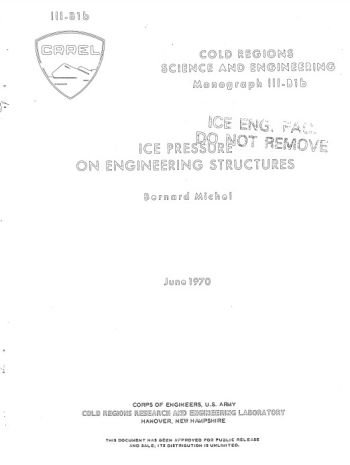Ice Pressure on Engineering Structures (CRREL III-B1b): Difference between revisions
(Created page with "{{References Template |author= <!-- Add author/publisher below--> United States Army Corps of Engineers |date= <!-- Add publication year --> 1970 |picture= <!--create a file below in format File:example.png, then add picture to that file--> File:CRELLIII.jpg |link= <!-- Add Url to document below (To retrieve URL from a pdf, add document as a pdf file and copy link address from its page--> https://3.238.206.13/images/c/c4/CRELLIII.pdf |abstract= <!-- Add document...") |
No edit summary |
||
| (One intermediate revision by one other user not shown) | |||
| Line 15: | Line 15: | ||
|link= | |link= | ||
<!-- Add Url to document below (To retrieve URL from a pdf, add document as a pdf file and copy link address from its page--> | <!-- Add Url to document below (To retrieve URL from a pdf, add document as a pdf file and copy link address from its page--> | ||
https:// | https://damtoolbox.org/images/c/c4/CRELLIII.pdf | ||
|abstract= | |abstract= | ||
Latest revision as of 23:30, 16 December 2022
United States Army Corps of Engineers, 1970

One of the most important forces in the design of a dam in northern regions is the horizontal thrust applied to the structure by a solid sheet of ice. Although much progress has been made in estimating this force, there ' is still a long way to go before we get an accurate design value for it, mainly because of the inadequate basic knowledge of the deformation behavior of ice.
With time, the analysis of this problem has been more and more refined and design values of this pressure have been successively lowered. At the beginning of the century, for instance, many dams were designed for the condition of crushing ice,3* which led to a value as high as 50 kip per linear foot.6.1 At present, some plastic properties of ice are being taken into account, and values used by Canadian engineers vary between 10 and 15 kips/ft for rigid structures. For more flexible structures, like sluice gates, values in the vicinity of 5 kips/ft are more commonly used.
The importance of a proper allowance for ice thrust is apparent when it is appreciated that for a dam 38 ft high, an 'ice thrust of 15,kips/ft has the same tendency to tip the dam as the water pressure it was designed to resist.
Revision ID: 5925
Revision Date: 12/16/2022
